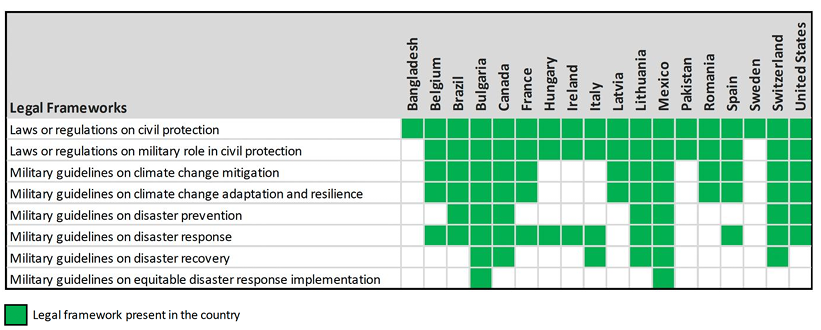Report published by the Environment & Development Resource Centre (EDRC), May 2025.
As climate change intensifies the frequency and severity of extreme weather events, civil-military cooperation has become increasingly essential for effective disaster management. This report, stemming from Project CASA (Climate and Security Action through Civil-Military Cooperation in Climate-Related Emergencies), assesses how national militaries contribute to resilience, readiness, and response during climate-related crises, and how this cooperation can be strengthened.
The imperative for civil-military cooperation:
Climate change poses serious and multifaceted threats to global security, including environmental, human, political, and economic. The number of climate-related disasters has increased five-fold since 1970, costing trillions and displacing millions. As civilian emergency systems struggle to cope, militaries have increasingly been called upon for their logistical expertise, rapid deployment, and infrastructure capacity.
However, this expanding remit has raised questions. Traditionally guided by the “last resort” principle, military involvement was considered appropriate only when no civilian alternative existed. The report argues this principle is under strain as military deployments become more frequent and necessary. From 2022 to early 2025 alone, over 500 military deployments related to climate hazards were recorded across 97 countries. The U.S. military, for example, deployed 393 times in 2023 in response to billion-dollar disasters, costing $2.6 billion.
Shifting operational norms and risks:
The normalization of military roles in disaster response is not without risks. Over-reliance may divert resources from core defence tasks and strain military personnel. Militaries also face increasing domestic and international demands, from national defence to climate-related humanitarian assistance, creating complex operational pressures.
Despite this, militaries offer unique strengths: heavy-lift equipment, aerial and maritime mobility, medical teams, and rapid response infrastructure. These capacities make them indispensable in large-scale disasters, particularly when civilian systems are overwhelmed. As such, the debate is shifting from whether militaries should be involved to how they can be integrated effectively into broader civil protection strategies.
Expanding scope: Beyond immediate response
The report identifies an evolution in military roles beyond immediate response into broader domains of disaster risk reduction (DRR). This includes prevention, mitigation, recovery, and adaptation. Militaries are now engaged in infrastructure fortification, flood management, and early warning systems. In the U.S., the Army Corps of Engineers plays a critical role in national flood defence, while the Canadian Armed Forces are increasingly involved in domestic disaster preparedness.
Prevention also includes internal adaptation. Militaries worldwide are contending with climate-induced risks to installations, supply chains, and personnel health. There is growing recognition that military operations must reduce their environmental footprint and prepare for climate-induced disruptions.
Internationalisation and coordination:
Climate disasters are increasingly transnational, prompting international military collaboration. Mechanisms like the EU Civil Protection Mechanism have facilitated joint responses. For e.g., when Canada requested European assistance during its 2023 wildfires. NATO, too, has become active through its Climate Change and Security Action Plan (2021) and the newly established Climate Change and Security Centre of Excellence in Montreal.
At the policy level, the EU’s 2025 Preparedness Union Strategy and its 2024 European Climate Risk Assessment embed military preparedness into whole-of-government climate security planning. NATO’s evolving mandate and partnerships with the UN, OSCE, and others highlight a growing trend of collective crisis management frameworks focused on climate resilience.
Country-level divergence and lessons:
Drawing from 18 country profiles, the report reveals stark diversity in how militaries are structured and deployed for climate emergencies. Three main models of legal frameworks emerge:
- General national frameworks without specific military roles (e.g., Sweden, Bangladesh).
- General civil protection laws that mention military roles (e.g., Pakistan).
- Detailed frameworks outlining military involvement in disaster response and climate resilience (e.g., Canada, France, Switzerland, Brazil, Italy).

Similarly, operational structures differ: some countries integrate civil protection training into existing units; others establish dedicated disaster response forces. Canada’s DART and Spain’s dedicated firefighting units are examples of this specialization. Civil-military coordination mechanisms, standard operating procedures, and training programs vary widely, influenced by national political cultures and capacities.
While no single model is endorsed, the report stresses that sharing experiences across contexts is vital. Good practices, such as local engagement, trust-building with civilians, and joint exercises, enhance civil-military synergies.
Data and research contributions:
A major innovation of Project CASA is its development of a cross-national dataset tracking military involvement in climate emergencies, spanning from 2012 to 2023. Using official government sources and expert validation, the dataset captures variables like disaster type, military agency, geographic location, activity type, and funding. It is the first effort to systematize military responses to climate-related disasters globally.
The project also proposes a new typology of military civil protection activities, classifying roles under prevention, preparedness, hazard containment, relief, operations, and recovery. This analytical framework provides clarity and comparability across national contexts.
Conclusion: A call for coherence and collaboration
The report underscores that militaries will continue to play an expanding role in climate emergency management. However, this trend demands clearer legal frameworks, stronger civil-military coordination, and investment in joint planning and prevention.
The path forward includes strengthening international institutional alignment, addressing military capacity trade-offs, and enhancing local partnerships for resilient and equitable disaster responses. As mitigation efforts fall short and climate threats escalate, adaptation through robust civil-military cooperation becomes not only pragmatic, but indispensable.
This text is based on extracts from a report published by the Environment & Development Resource Centre (EDRC) in collaboration with the Climate Security Association of Canada (CSAC), Crisis Management and Disaster Response Centre of Excellence (CMDR COE), Foundation for Global Governance and Sustainability (FOGGS) and Global Military Advisory Council on Climate Change (GMACCC), May 2025. To read the complete paper, follow the link here.
See below for our coverage on similar topics:
- Military Action on the European ‘Climate Front’
- Extreme weather as the new normal
- NATO and climate change: Towards a joint understanding and response



